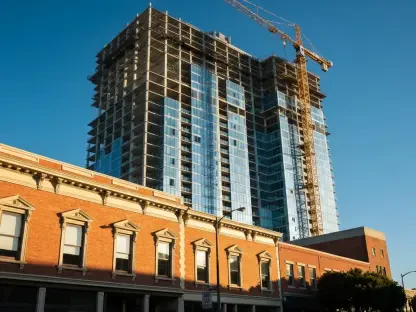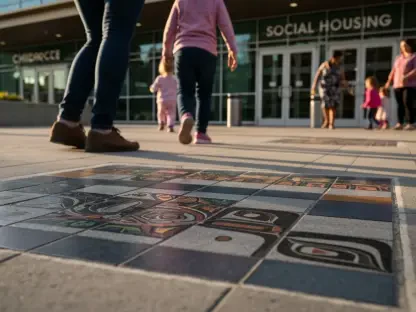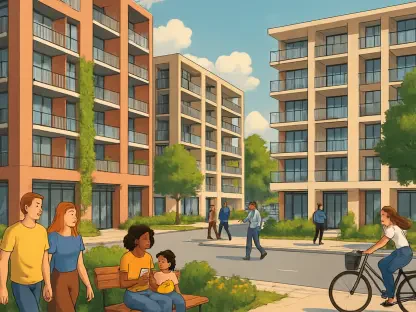The United States construction industry is grappling with a significant labor shortage that profoundly affects the sector’s productivity and the broader national economy. A recent study by the University of Denver, in collaboration with the Home Builders Institute (HBI) and the National Association of Home Builders (NAHB), unveiled the depth of this crisis. The findings reveal that the labor shortfall is not just a hurdle for the industry but poses wider economic implications by costing approximately $10.8 billion annually. The shortage has led to prolonged construction timelines, thereby impacting the availability of affordable housing across the country. As the construction industry endeavors to overcome this challenge, it becomes essential to examine the multifaceted dimensions contributing to the labor deficit and explore viable solutions.
The Widespread Impact of Labor Shortages
Decline in Productivity and Housing Availability
The current state of the construction labor market highlights a direct correlation between labor shortages and decreased productivity levels. Due to this skilled labor deficit, the industry is expected to build around 19,000 fewer single-family homes in the current year alone. The decline in productivity not only delays the completion of existing projects but also limits the onset of new ones. On average, construction timelines are extended by nearly two months, with smaller home builders experiencing even longer delays, averaging 2.36 months. These setbacks contribute to the ongoing housing crisis, underscoring the inadequate supply of affordable homes, which remains a persistent issue nationwide.
These shortages are exacerbated by external factors such as the COVID-19 pandemic and restrictive immigration policies, which hinder workforce availability. The pandemic resulted in the loss of nearly a million construction jobs, many of which have yet to be recovered. Dependence on immigrant labor, particularly undocumented workers, further complicates the scenario. Immigration clampdowns, including deportations, have intensified the strain on the workforce. Estimates suggest that between 700,000 and 1 million undocumented workers are part of the construction labor force, and their removal would severely impede an already struggling sector. The need for strategic interventions to address the lack of skilled labor is not just an industry-specific concern but a pressing national priority.
Economic Ripple Effects and Industry Initiatives
Construction is a critical pillar of the U.S. economy, and labor shortages ripple well beyond the industry boundaries. This crisis impacts national economic health by slowing down housing development, affecting supply chains, and escalating housing costs. NAHB Chief Economist Robert Dietz stresses that rectifying the labor shortage is imperative for sustaining economic growth. Efforts to bridge existing gaps and prepare for future demands are underway, with companies increasingly investing in workforce development. By focusing on training and education, the industry aims to equip workers with necessary skills, thereby enhancing productivity and boosting overall economic resilience.
Moreover, collaborative efforts between construction firms and industry associations like HBI and NAHB indicate a growing commitment to solving the labor gap. These organizations have expanded training programs, offering industry-recognized certifications and innovative hands-on training methods. This expansion not only seeks to upskill the current workforce but also aims to attract new entrants into the field. The widespread availability of such training programs encourages participation from diverse demographics, thereby widening the talent pool and fostering economic robustness.
Technological and Educational Solutions
Embracing Technological Advancements
Within this context, the integration of technological solutions is becoming increasingly vital. As labor shortages persist, construction firms are turning to automation and innovative building techniques such as modular construction. These methods promise to enhance efficiency and sustainability while reducing dependence on traditional labor-intensive practices. Automation in the construction process can streamline operations, optimize resources, and safeguard quality. Emphasizing technological investment allows the industry to adapt to labor constraints and meet growing housing demands with greater agility.
The adoption of alternative construction methods aligns with the industry’s broader trend towards embracing innovation. Modular building, which involves pre-fabricating components off-site, helps speed up the construction process and minimizes waste. This approach not only addresses labor shortages by requiring fewer on-site workers but also aligns with sustainability objectives by reducing the environmental footprint. As these technological solutions prove their worth, they are likely to gain a stronger foothold in the industry, helping balance labor dynamics with modern construction needs.
Role of Education and Training Programs
Complementing technological advancements are educational and training initiatives that aim to develop a skilled workforce capable of thriving in a modernized industry. Organizations like HBI play a pivotal role in equipping the next generation with the relevant trade skills needed for success. By offering hands-on training and educational pathways, they open doors for individuals who might not have considered construction as a career choice. These programs broaden awareness of construction opportunities and serve critical social purposes, fostering economic mobility and diversifying the workforce.
Encouraging more individuals to enter the construction field starts with reshaping perceptions and showcasing the industry’s potential. Educational outreach campaigns and partnerships with educational institutions can effectively highlight construction careers as viable, rewarding pathways. By investing in workforce development, the industry can strategically address skill shortages and ensure sustained growth. This commitment to education and innovation indicates a proactive stance in tackling labor challenges head-on.
Strategic Outlook for the Future
The current scenario in the construction labor market underscores a clear link between labor shortages and reduced productivity. This deficit in skilled labor means the industry will construct about 19,000 fewer single-family homes this year. With productivity plummeting, not only are existing projects delayed, but the start of new ones is hampered. Typically, construction timelines are lengthened by nearly two months, and for smaller builders, the delays can extend to approximately 2.36 months. These delays exacerbate the ongoing housing crisis by curtailing the supply of affordable homes, a persistent national issue.
External factors like the COVID-19 pandemic and strict immigration policies further worsen these shortages. The pandemic led to the loss of nearly one million construction jobs, many of which remain unfilled. The sector’s reliance on immigrant labor, especially undocumented workers, complicates matters. Immigration enforcement, including deportations, heightens the workforce’s strain. With estimates indicating that 700,000 to 1 million undocumented workers are in construction, their removal could cripple the industry. Addressing this skilled labor shortage is not only critical for the sector but a national imperative.









